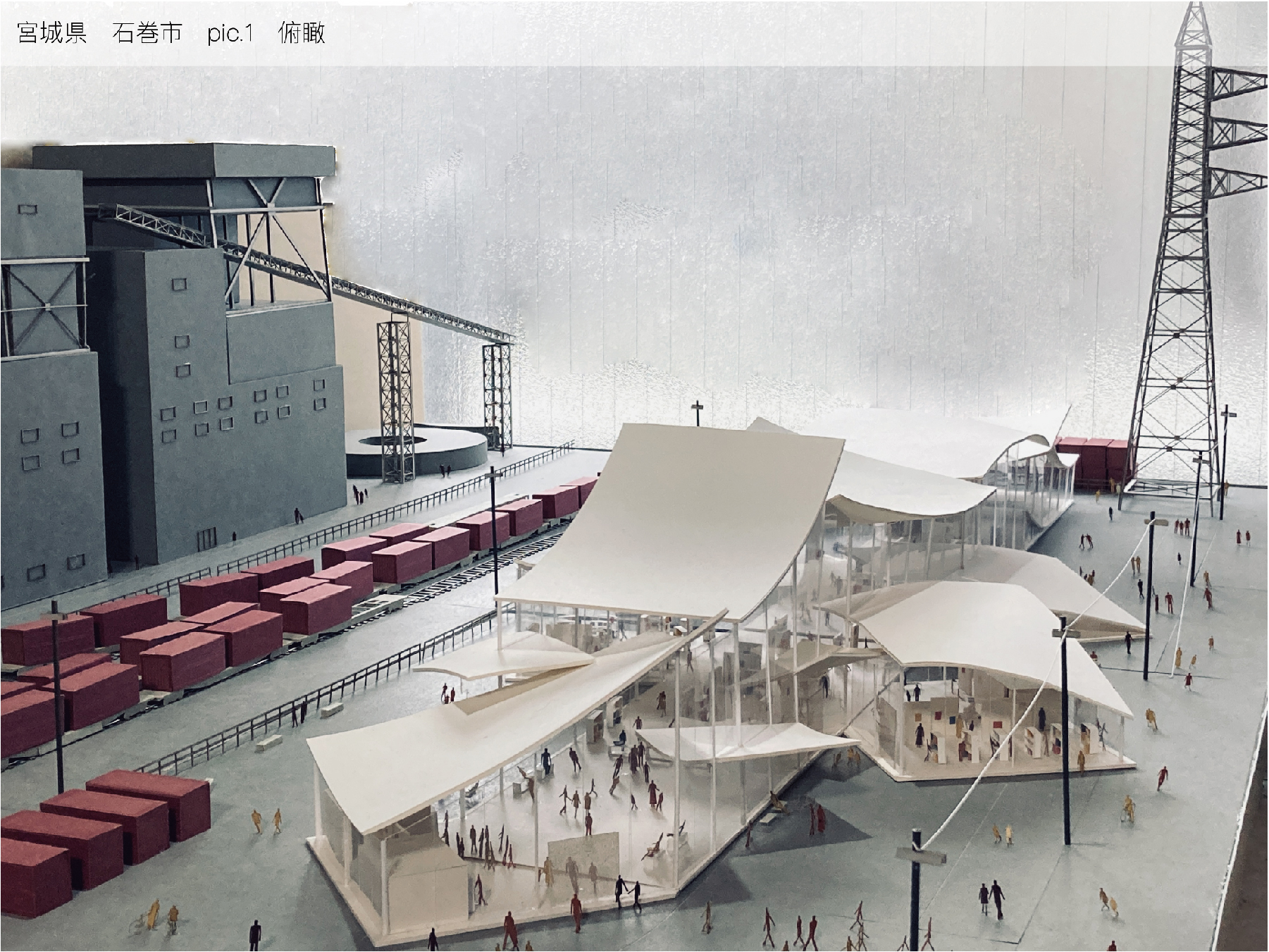
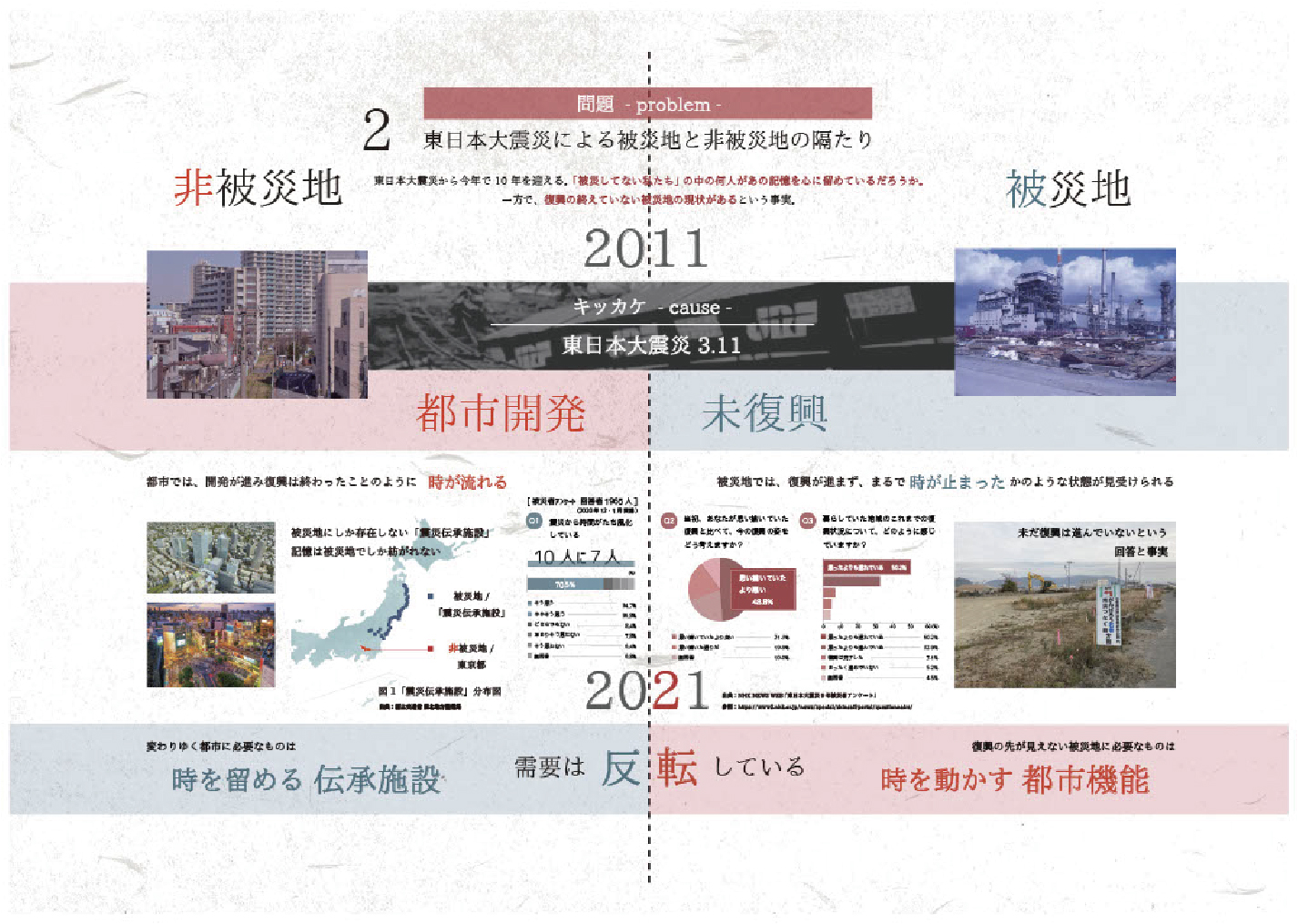
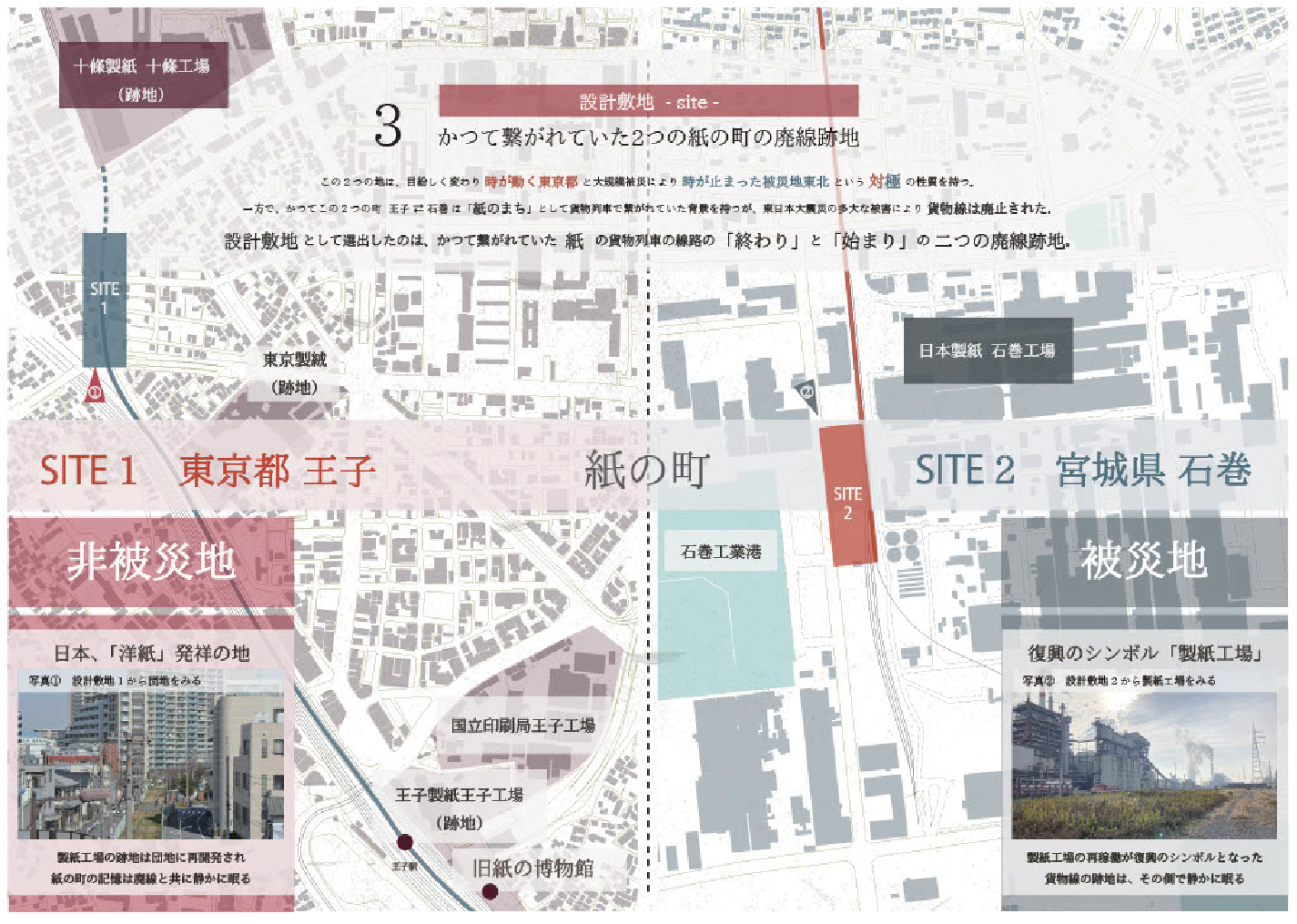
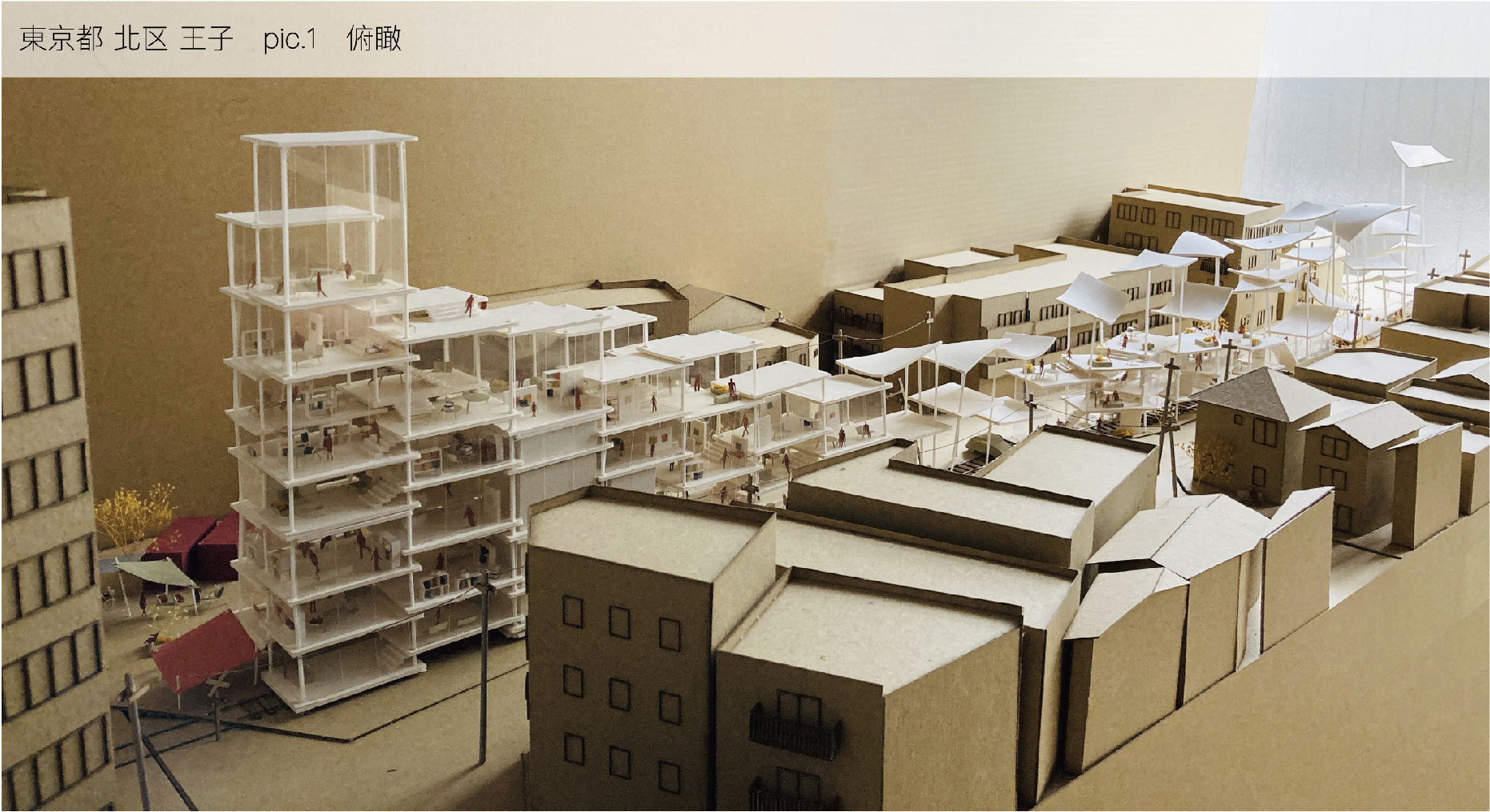

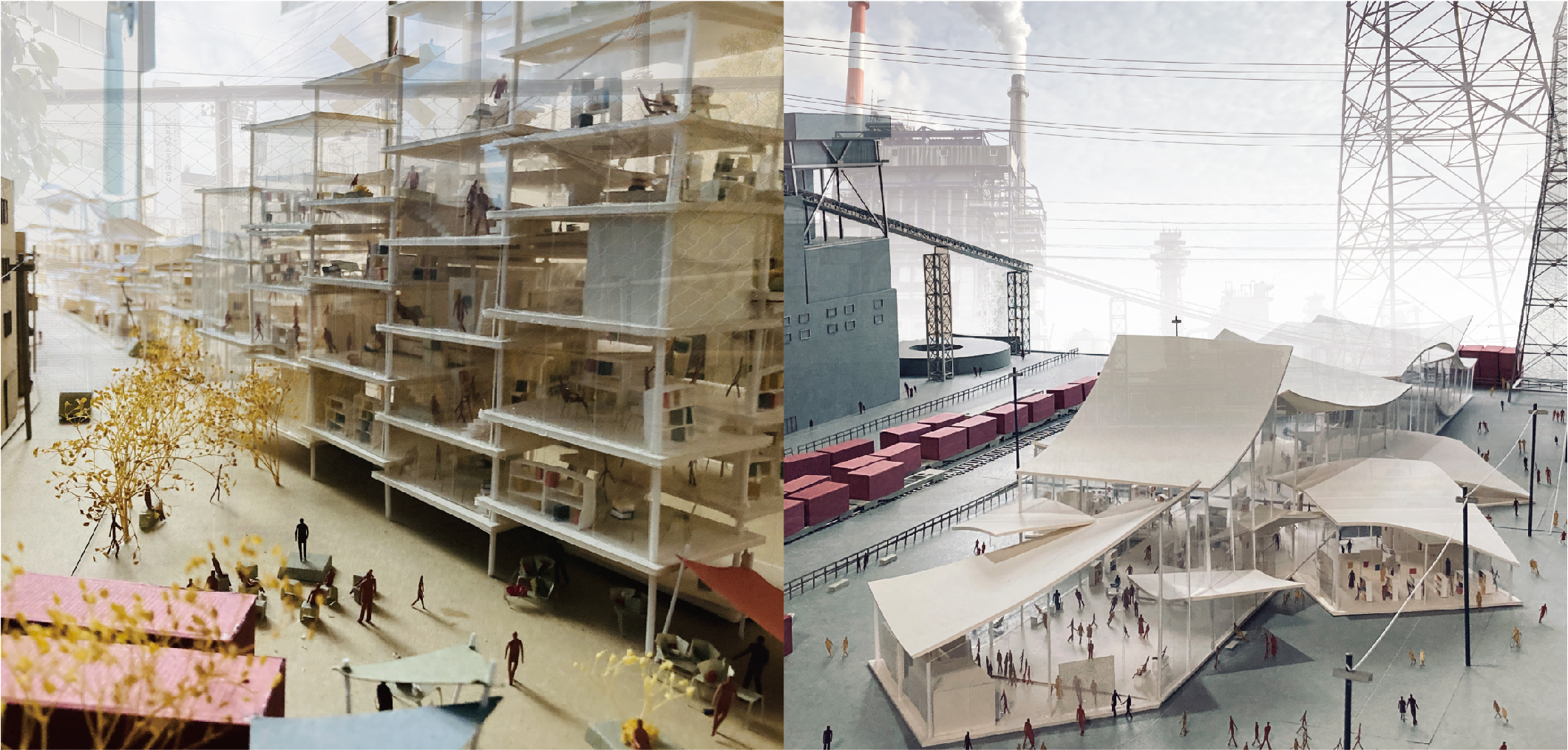







「write」〜Dear you 400km away〜/
日本 / japan
海老原耀 / EBIHARA Akira
東京都王子的舊紙廠工廠遺跡與宮城縣石卷的製紙工程廠,遠離400km的兩地,曾經為運輸紙的貨物列車而連結,但因東日本大地震而斷裂。從震災至今10年,相隔400km的災區以及非災區之間對震災的意識也產生了落差。災區到此為止還沒恢復,在東京,好像已完畢重建的態度下,新的開發如此進行中。以往為了運輸紙而連結的貨物列車的路線,依它的「起點」及「終點」為設計基地,快被遺忘的東日本大地災,在東京作為石卷震災紀念館,在石卷迎接來自東京的民眾的MICE設施,場所反轉的手法,讓兩地重新連結。就像造紙廠的機能道地區間的書信往返,明信片一般的屋頂一邊是整齊排列、一邊是散落飛舞的樣子的108封信,在兩端創造出了建築空間。
東京都王子の旧製紙工場跡と宮城県石巻の製紙工場は紙を運ぶ貨物線で繋がれていたが、東日本大地震をキッカケに途切れてしまった。震災から10年が経った今、400km離れた被災地と非被災地には震災意識の格差が生じてしまった。被災地は未だ復興が終わらずにいる中、東京都心では復興が終わったことのように開発が進む。かつて繋がれていた紙の貨物線路の「始まり」と「終わり」を設計敷地とし、忘れ去られつつある東日本大震災の記憶を、東京では石巻の震災ミュージアム、石巻では東京の人々を招くMICE施設として、場を反転する様に建築を作ることで、両地域を結び直す。製紙工場という機能から、地域間の手紙のやり取りのように、ハガキのようなルーフが片や整然と、片や舞い散る様に、108枚の手紙が双方に建築空間を作り出す。
The former paper mill in Oji, Tokyo, and the paper mill in Ishinomaki, Miyagi Prefecture, were connected by a freight line carrying paper. In order to reconnect the two regions, the architecture is designed to reverse their places, with Tokyo serving as a museum of the earthquake in Ishinomaki and Ishinomaki serving as a MICE facility inviting people from Tokyo. The function of the paper mill is to create an architectural space for both sides, like the exchange of letters between the regions, with 108 letters neatly arranged on one side and scattered on the other.
More Projects of this Session
展區其他作品
東京都王子的舊紙廠工廠遺跡與宮城縣石卷的製紙工程廠,遠離400km的兩地,曾經為運輸紙的貨物列車而連結,但2011年3月11日發生東日本大地震而斷裂,從震災至今10年,受到龐大的災害,這條軌道已廢線,遺跡某某地留在雙方的城鎮之中。遠離400km的災區以及非災區之間對震災的意識也產生了落差。災區到此為止還沒恢復,在東京,好像已完畢重建的態度下,新的開發如此進行中。
然而在時間凝固的災區,設計了讓時間可以恢復流動的都市機能,在時間流動的東京,設計讓時間可以留存寫下來的震災傳承的設施,兩個地區的需求是「反倒」。以往為了運輸紙而連結的貨物列車的路線,依它的「起點」及「終點」為設計基地,快被遺忘的東日本大地災,在東京作為石卷震災紀念館,在石卷迎接來自東京的民眾的MICE設施,場所反轉的手法,讓兩地重新連結。把東京都王子與宮城縣石卷相距400公里的兩個城鎮的「Volume. scal .program」反轉而成的城市與建築的「差異」,將成為想起兩地間連結的契機。另外,就像以信紙聯繫在一起似的兩個城市間的書信往來一樣,明信片一般的屋頂一邊是整齊排列、一邊是散落飛舞的樣子的108封信,在兩端創造出了建築空間。
東京都王子の旧製紙工場跡と宮城県石巻の製紙工場、400km離れた二つの地は紙を運ぶ貨物列車で繋がれていたが、2011年3月11日、東日本大地震をキッカケに途切れてしまった。震災から今年で10年が経った。多大な被害を受け、廃線となった跡地が双方の町中に静かに残っている。400km離れた被災地と非被災地には震災に対する意識に格差が生じてしまった。被災地は未だ復興が終わらずにいる中、東京都心では復興が終わったことのように新しい開発が進む。時が止まったような被災地には時を動かす都市機能、時が流れる東京では時を留めて綴っていく震災の伝承施設、二つの町の需要は「反転」している。かつて繋がれていた紙を運ぶ貨物線路の「始まり」と「終わり」を設計敷地とし、忘れ去られつつある東日本大震災の記憶を、東京では石巻の震災ミュージアム、石巻では東京の人々を招くMICE施設として、場を反転する様に建築を作ることで、両地域を結び直す。東京都王子と宮城県石巻、400km離れたそれぞれの町の要素「ヴォリューム・スケール・プログラム」を「反転」させるように建築を作ることで生じる町と建築の「ズレ」が二つの地の繋がりをもう一度想起させるキッカケとなる。また、かつて紙によって繋がれていた二つの町を地域間の手紙のやり取りのように、ハガキのようなルーフが片や整然と、片や舞い散る様に、108枚の手紙が双方に建築空間を作り出す。
The ruins of a former paper mill in Oji, Tokyo, and a paper mill in Ishinomaki, Miyagi Prefecture, two places 400 kilometers apart, were connected by a freight train carrying paper, but were cut off after the Great East Japan Earthquake on March 11, 2011. Ten years have passed since the earthquake. There is a gap in awareness of the disaster between the affected and non-affected areas, which are 400km apart. While the affected areas are still recovering from the disaster, new developments are underway in central Tokyo as if the recovery is over. In the disaster area, where time seems to have stopped, there are urban functions that keep time moving, while in Tokyo, where time is still moving, there are facilities that preserve and preserve the legacy of the disaster. The design site is the “beginning” and “end” of a freight line that used to carry paper, and the two areas are reconnected by creating an architecture that reverses the place of the forgotten memories of the Great East Japan Earthquake, as a museum of Ishinomaki’s disaster in Tokyo and a MICE facility that invites people from Tokyo to Ishinomaki. By creating architecture that “reverses” the volume and scale programs of the two cities, 400 km apart, the “gap” between the cities and the architecture will serve as a catalyst for reconnecting the two places. In addition, like the exchange of letters between the two towns, which were once connected by paper, the 108 letters create architectural spaces on both sides, as if the postcard-like roofs were neatly arranged on one side and scattered on the other.